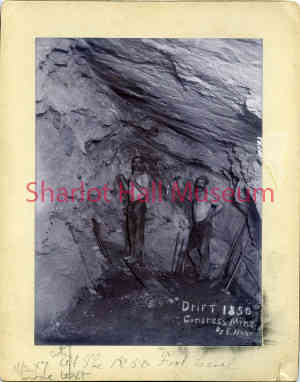Congress Miners inside an 1850' Drift
details
E. Noon Unknown 1600.0160.0003.jpg M - 160 B&W 1600-0160-0003 m160pc Print 8x10 Historic Photographs 1890s Reproduction requires permission. Digital images property of SHM Library & ArchivesDescription
Congress Miners inside a drift at the 1850 foot level, Martinez Distict, Yavapai County, Arizona.
The mine was located at an elevation of 3396 feet. Its’ main commodities were gold and silver, as well as copper, lead and uranium.
Congress, and the Congress Mine, boomed in the 1890's with the arrival of the railroad just a few miles away at Congress Junction. New investors poured money into the mine's infrastructure. The Congress mine, also nicknamed “Queen of the Hills,” became for a time one of Arizona's largest gold producers. An article in the December 22, 1897 edition of the Arizona Weekly Journal Miner boasted: “A visit to the Congress Mine would convince the most skeptical of the mineral resources of the southern part of the county. The pay roll at Congress embodies 425 men and this number is regularly employed. The present mines have plenty of gold in sight…” A population of 2000 supported a number of saloons, stores, theatres, schools and professional offices.
The life of a hard rock miner, however, was not an envious nor easy one. They lived in crude shacks and boarding houses with thin plank partitions, they worked in and many time collapsed from heat exhaustion in mines that went 2,000 feet underground and they froze in outdoor privies. Occupational hazards included mine collapses, drilling mishaps, pneumonia, “miner’s consumption,” and rheumatism. Falls were a common cause of death. Some miners were injured in explosions or electrocuted. Others fell off ladders, slipped on rocks, inhaled silica dust, or suffered from mercury, lead or arsenic poisoning. Many got sick from drinking dirty water and living too close together.
Simple candles and lamps provided the only light in a mine’s underground drifts and winzes. They burned 24 hours a day. Temperatures surpassed 100 degrees Fahrenheit at depths of 1500’ and beyond. Miners wore minimal attire, breechcloths or long underwear bottoms only. Narrow-brimmed hats or felt skullcaps and rudimentary shoes were the extent of their “safety equipment.”
“The deeper they went, the hotter it got.” (Time-Life Books, 1976, The Old West, The Miners, p. 77.) At such depths, the rock they drilled was customarily too hot-to-the-touch. Scalding steam and/or hot water often flowed from crevices or drilled holes in the walls of a mine’s interior. Some relief was provided by blowers staged on the surface of a mine, it forced cooler air into the depths of a mine thru a network of pipes. Workmen were provided with copious amounts of water and sometimes ice that they could chew on. Because of the heat, men could only work about one half hour at a time or face collapse from heat exhaustion.
During the 1950’s, after the mine shut down, the town didn't last long and the post office was moved to the railroad hub at Congress Junction. Leasers perodically worked the many tailings for the next thirty years. Traces of wooden buildings, foundations and numerous huge white and pink tailings' dumps remain, Today, the town known as "Congress" is actually old Congress Junction, and little remains of the original town site.
Purchase
To purchase this image please click on the NOTIFY US button and we will contact you with details
The process for online purchase of usage rights to this digital image is under development. To order this image, CLICK HERE to send an email request for details. Refer to the ‘Usage Terms & Conditions’ page for specific information. A signed “Permission for Use” contract must be completed and returned. Written permission from Sharlot Hall Museum is required to publish, display, or reproduce in any form whatsoever, including all types of electronic media including, but not limited to online sources, websites, Facebook Twitter, or eBooks. Digital files of images, text, sound or audio/visual recordings, or moving images remain the property of Sharlot Hall Museum, and may not be copied, modified, redistributed, resold nor deposited with another institution. Sharlot Hall Museum reserves the right to refuse reproduction of any of its materials, and to impose such conditions as it may deem appropriate. For certain scenarios, the price for personal usage of the digital content is minimal; CLICK HERE to download the specific form for personal usage. For additional information, contact the Museum Library & Archives at 928-445-3122 ext. 14 or email: orderdesk@sharlot.org.




